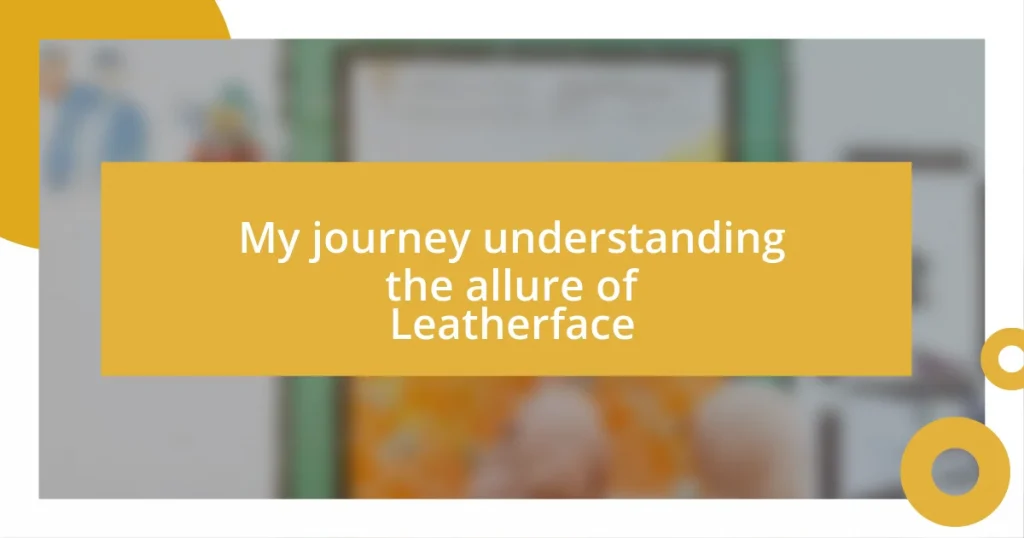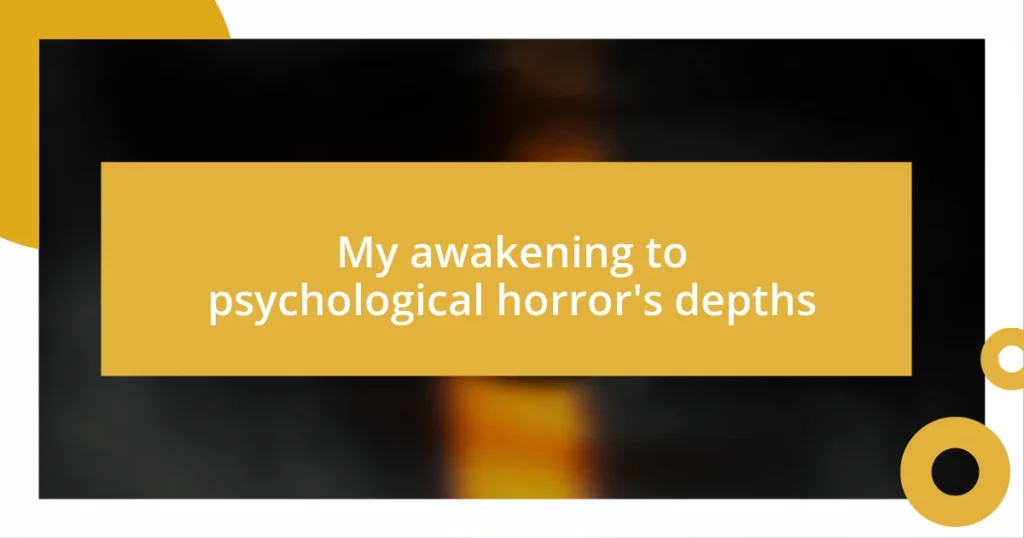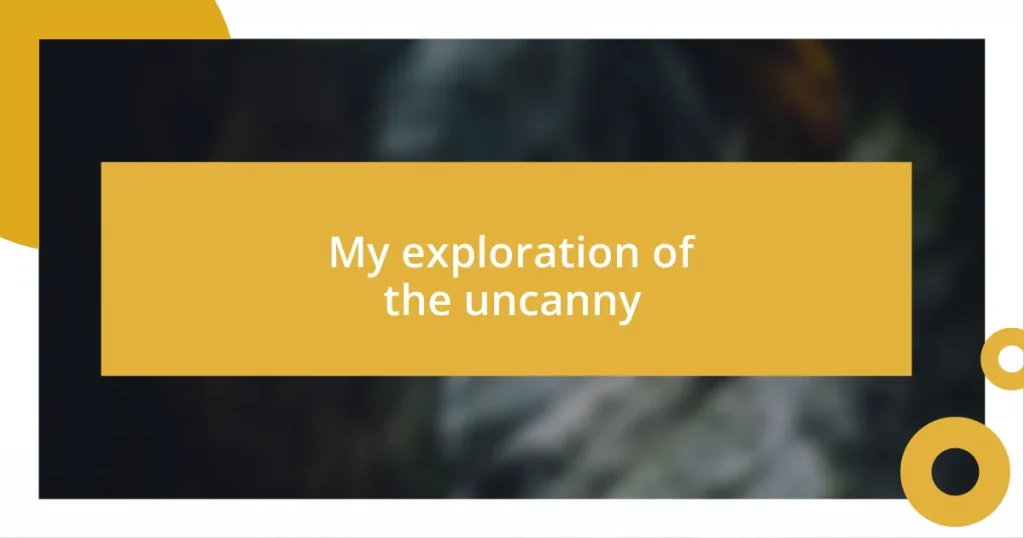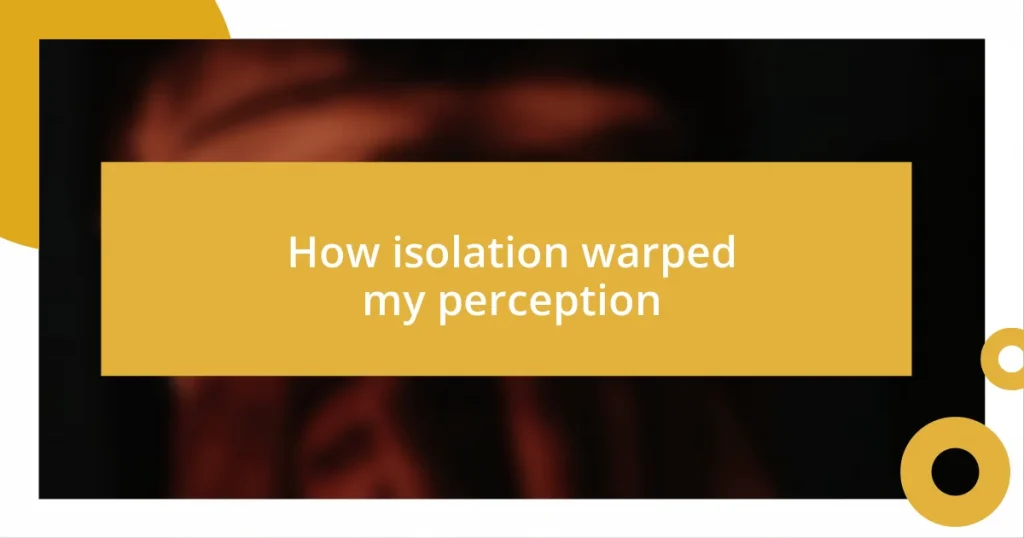Key takeaways:
- Leatherface’s character evokes a complex blend of fear and empathy, prompting reflections on trauma, identity, and societal dysfunction.
- His mask symbolizes the struggle for identity and acceptance within a violent family dynamic, highlighting the broader theme of alienation in society.
- Leatherface’s cultural impact spans various media, enabling discussions about the nature of fear, representation, and societal critique, while also allowing for reinterpretation in contemporary contexts.
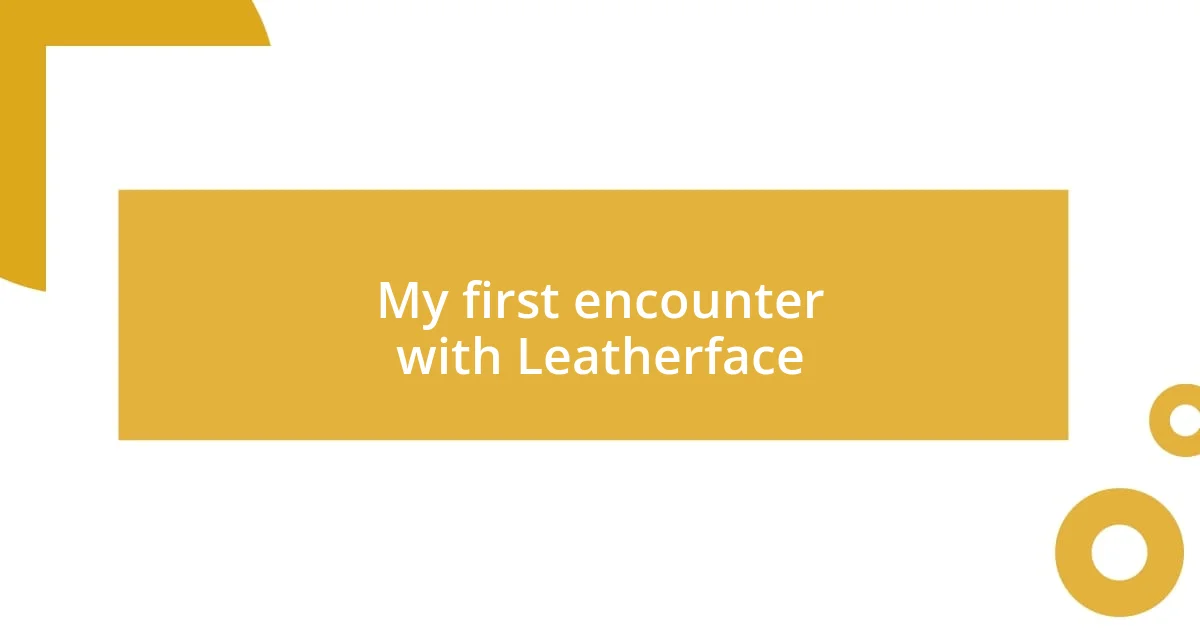
My first encounter with Leatherface
I vividly remember the first time I encountered Leatherface; it was during a late-night movie marathon at a friend’s house. As the opening scenes of “The Texas Chainsaw Massacre” flickered on the screen, a knot formed in my stomach. The sheer intensity of his presence made me wonder, how could a character evoke such raw fear while also captivating my interest?
When Leatherface made his first striking appearance, I felt an inexplicable mix of dread and fascination. It was surreal watching him wield that chainsaw, but what struck me the most was his distorted humanity. I found myself questioning the nature of fear itself: why was I both repulsed and oddly drawn to this character?
Reflecting on that night, I can still feel the adrenaline rush that came with the suspense. What is it about Leatherface that lingers in the mind long after the credits roll? The haunting imagery has stayed with me, prompting me to explore the deeper layers of his character and the social commentary embedded within the horror genre.
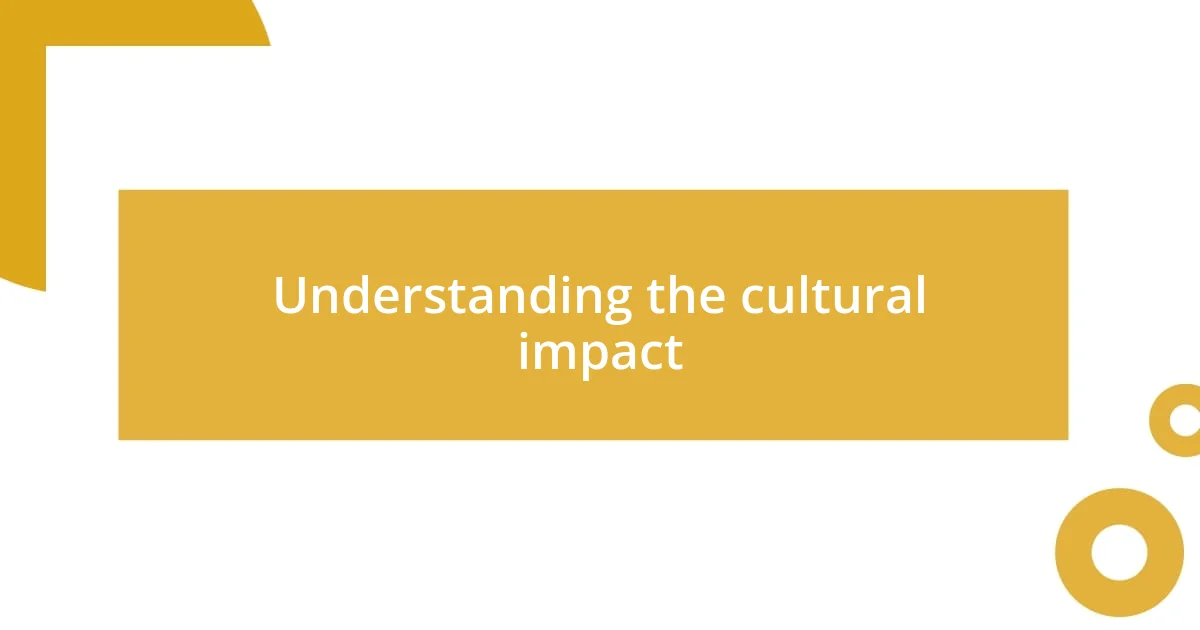
Understanding the cultural impact
Understanding the cultural impact
The figure of Leatherface has transcended mere horror movie villainy; he has become an icon of American popular culture. Growing up surrounded by media representations of fear, I found Leatherface to be a paradox that challenged my understanding of masculinity and violence. His portrayal resonates not just as a terrifying character but as a cultural critique of societal decay and the dark undercurrents of American life.
I remember discussing Leatherface with friends after watching the film. We found ourselves drawn into a deep conversation about his character and the unsettling way he embodies the effects of trauma and neglect. The more we talked, the more I realized how his story reflects broader themes of familial dysfunction and alienation, making him a complex figure in the tapestry of horror cinema.
The cultural impact of Leatherface also extends to various forms of media today, inspiring everything from Halloween costumes to references in music and art. I often see his influence cropping up in contemporary horror narratives that strive to explore the human condition. This connection showcases how a character born from fear can become a mirror reflecting societal truths, deepening our understanding of what it means to exist in a fragmented world.
| Cultural Impact | Examples |
|---|---|
| Representation of Fear | Leatherface as an embodiment of societal dread |
| Commentary on Family Dynamics | His violent nature reflects dysfunctional family relationships |
| Influence on Modern Media | Inspired films, music, and art, affirming his lasting legacy |
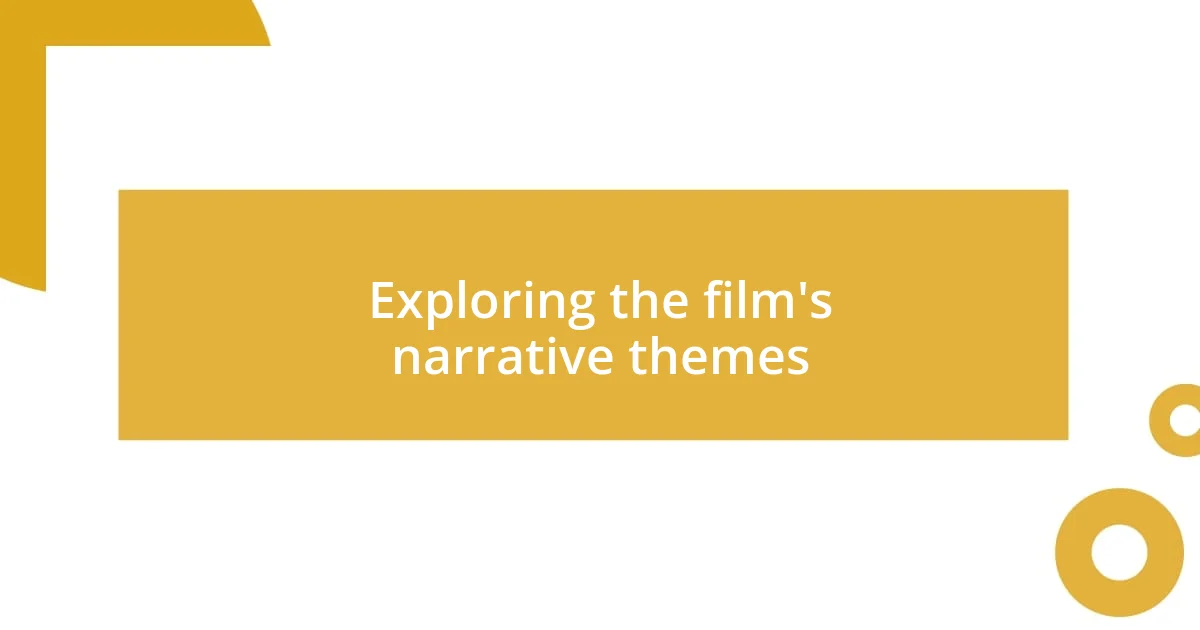
Exploring the film’s narrative themes
The narrative themes in “The Texas Chainsaw Massacre” are as chilling as they are compelling. One of the strongest elements is the exploration of survival against insurmountable odds. I recall a particular scene that sent shivers down my spine: the desperate scramble for escape, steeped in sheer terror. It taps into a primal instinct we all share—what would we do to survive? This question lingers beyond the screen, forcing viewers to confront their own fears and moral boundaries.
In addition to survival, the film delves into themes of family and identity, particularly regarding the grotesque portrayal of familial bonds. Leatherface’s interactions reveal an unsettling depiction of loyalty mixed with violence. It creates a warped sense of belonging that feels all too relatable in the context of dysfunctional relationships.
Here are some of the key narrative themes explored in the film:
- Survival Instinct: The characters’ battles reflect the human desire to endure despite chaos.
- Familial Dysfunction: The family unit in the film shows how bonds can foster not just love, but also harm.
- Identity Crisis: Leatherface embodies the struggle between humanity and monstrosity, blurring the lines of what we consider ‘normal.’
- Isolation and Alienation: The characters’ dire situations highlight a disconnect from society, amplifying their vulnerability.
I find myself pondering how these themes resonate with audiences today. They create a haunting dialogue about our own lives and fears, reminding us that the horror genre often serves as a dark mirror to our societal struggles. Each viewing seems to reveal new layers, keeping the story alive in the imagination.
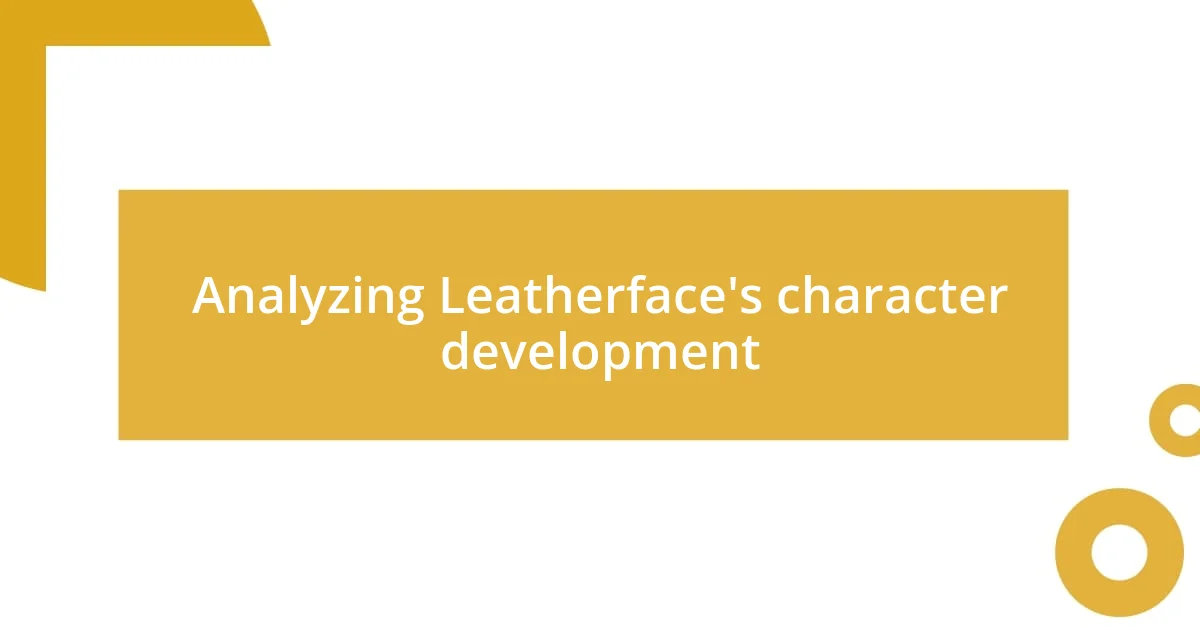
Analyzing Leatherface’s character development
Leatherface’s character development is intricately tied to the themes of trauma and identity. I remember the first time I saw him on screen, his violent disposition evoked not just fear but a strange sorrow. There was something haunting about a creature created from neglect, trapped in a world where he could only express his pain through brutality. Can you see how this tragic backstory adds depth to what could otherwise be a one-dimensional horror villain?
As I delved deeper into Leatherface’s evolution throughout the series, I noticed that each subsequent portrayal amplifies his internal struggle. The mask he wears—and the literal masks he makes—serve as symbols of his desire to hide from the world and his own fractured identity. This idea resonated with me; I often think about how we all wear masks in different contexts. What happens when those masks become a part of who we are?
Over time, Leatherface emerges as a figure marked by contradiction. He can be both terrifying and pitiable, acting as a reflection of the chaos within his family and society at large. I’ve found it fascinating how discussions about him often lead us to confront uncomfortable truths about our own familial relations. Isn’t it remarkable how a character shrouded in horror can force us to reflect on our humanity and the very nature of monstrosity? The more I explore this character, the more I uncover layers that challenge my perceptions of violence and empathy.
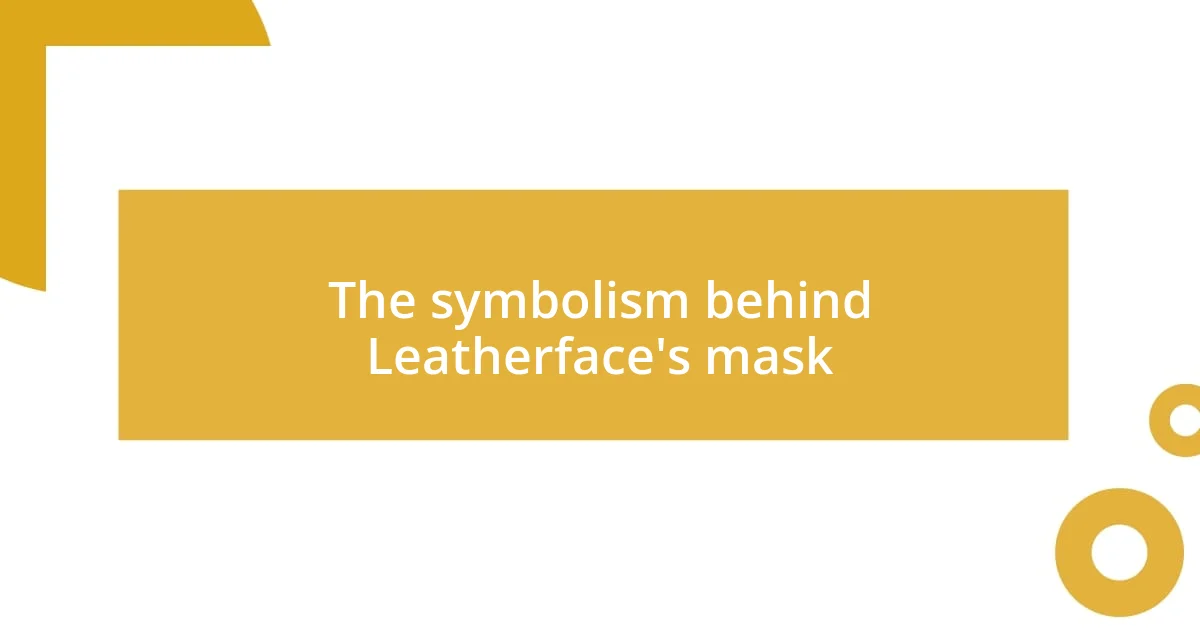
The symbolism behind Leatherface’s mask
Leatherface’s mask serves as a powerful symbol of identity and transformation. I remember the first time I saw him in that hideous mask made from human skin; it hit me that it wasn’t just a disguise but a way for him to escape his own pain. What struck me then—and still lingers—is how we sometimes hide behind our own masks to shield ourselves from the world’s harsh judgments. Isn’t it fascinating how a simple piece of horror could reflect our own struggles with self-identity?
The masks Leatherface wears also signify the roles he’s forced to play within his twisted familial structure. It’s almost heartbreaking when you think about it—each mask represents a different face he presents to those around him. In that moment, I imagined what it must feel like to lose one’s true self amid chaos. Their layers are not just about deceit; they’re a reflection of his longing for acceptance in a family that thrives on violence. What happens when we become so consumed by those roles that we forget who we originally were?
Ultimately, Leatherface’s mask is an embodiment of societal rejection and isolation. I can’t help but contemplate this reality—how many people feel they have to wear a mask to fit in, just like him? The film amplifies these themes through horror, forcing us to grapple with our own experiences of alienation. It’s this emotional connection that makes Leatherface more than just a monster; he incarnates a struggle that resonates deeply within our own lives, reminding us of the masks we may wear every day.
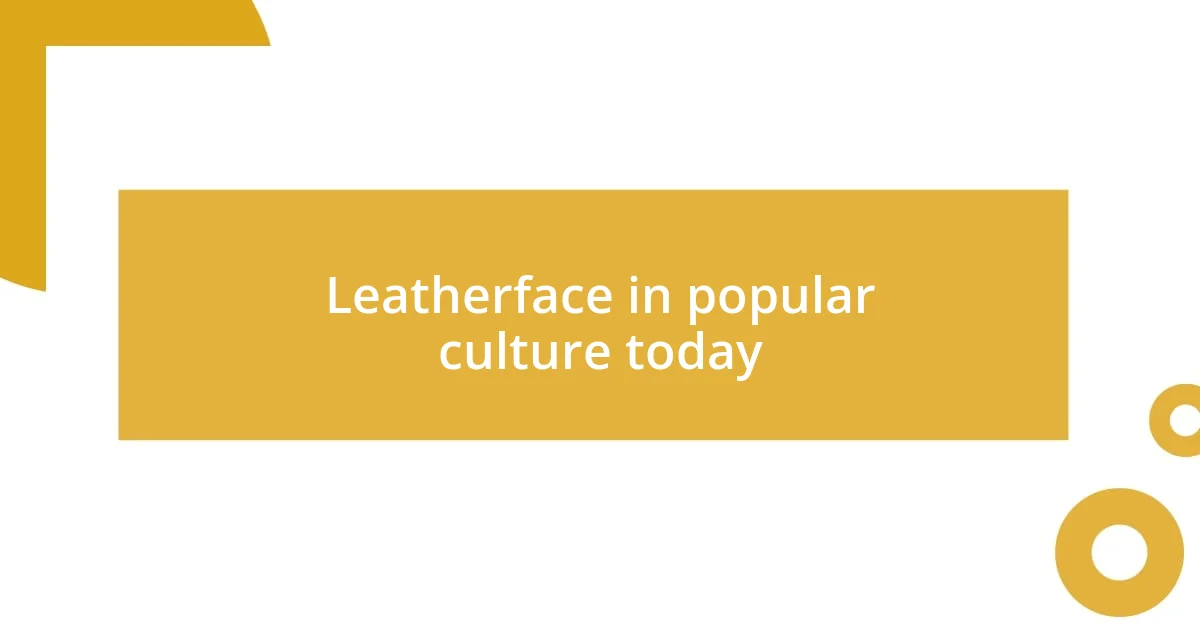
Leatherface in popular culture today
Leatherface’s presence in contemporary culture is nothing short of fascinating. Recently, I stumbled upon a series of social media memes featuring him, blending his monstrous persona with humor. It made me think about the duality of fear and laughter—how we sometimes cope with horror by turning it into a punchline. Isn’t it intriguing how a character rooted in terror can be reimagined in ways that resonate with today’s audiences?
In film and video games, Leatherface remains a compelling figure that sparks intense discussions. I recall watching a horror-themed documentary that explored his impact, where viewers debated whether he represents pure evil or a byproduct of his environment. This complexity adds layers to his character that keep audiences returning to dissect his motivations. What role do we play in the creation of monsters—both on-screen and in our world?
Moreover, I see Leatherface frequently referenced in art and fashion, further blurring the lines between horror and mainstream culture. I remember attending a convention where artists showcased Leatherface-inspired pieces, transforming him into a symbol of rebellion rather than fear. When does leather become a statement of style instead of an emblem of violence? These interpretations showcase how the character has evolved over time, allowing each generation to express their angst through his lens. It’s a reminder that even in horror, there’s room for dialogue and reflection.
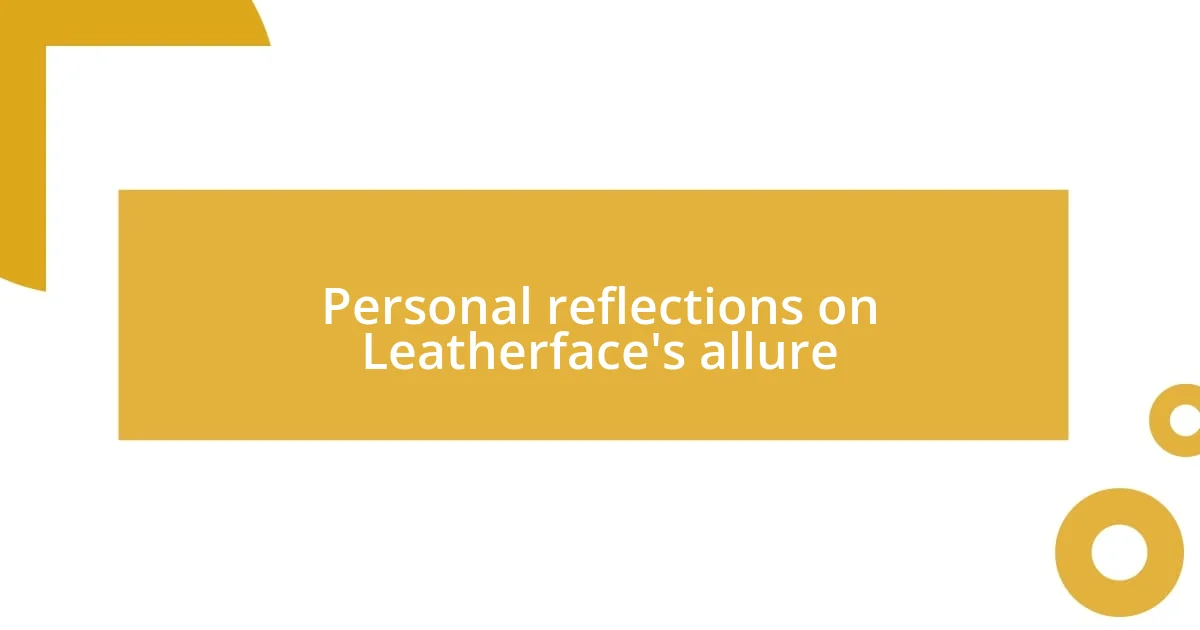
Personal reflections on Leatherface’s allure
Somewhere along my journey of understanding Leatherface, I found myself grappling with the paradox of his character. I remember sitting in my living room, watching the original film late at night, feeling an eerie connection to his plight. Despite the gruesome nature of his actions, I was struck by this haunting question: what kind of pain drives someone to such extremes? Those moments peeled back the layers of horror, revealing a tragic figure fighting against the very demons that haunt so many of us.
Reflecting on my own experiences, I realize that Leatherface embodies a struggle that transcends the screen. There have been times when I felt trapped by external expectations, much like he is confined by his family’s sinister legacy. It makes me think about the masks we wear—not just his grotesque facade but the everyday roles we play to navigate societal pressures. How often do we sacrifice our true selves in pursuit of acceptance? It’s a reminder of how our deepest fears can transform us into versions of ourselves that might seem unrecognizable.
As I engage with Leatherface’s narrative, I also acknowledge the uncomfortable allure he possesses—a blend of horror and empathy. I vividly recall discussing his character with friends over coffee, where we debated whether he could ever be redeemed. That conversation opened my eyes to the humanity within his monstrosity, pushing me to reconsider my perception of evil. Isn’t it fascinating how a figure so monstrous can provoke such profound introspection about our own capacity for empathy and understanding? Leatherface serves as a shadowy mirror, reflecting the darker parts of our identity that we often prefer to ignore.










